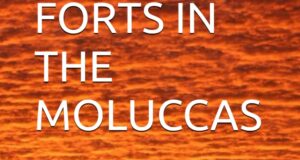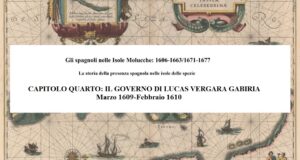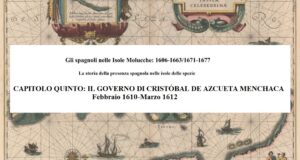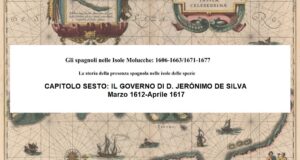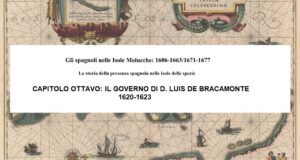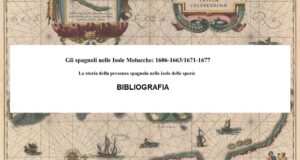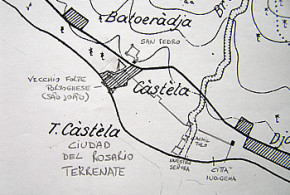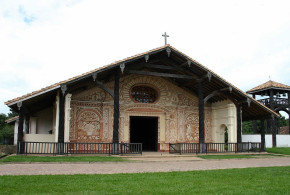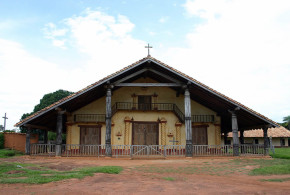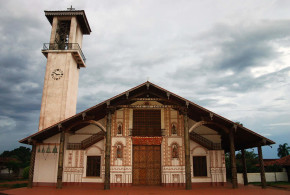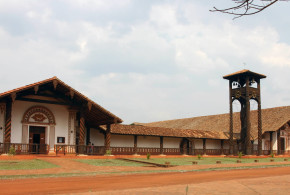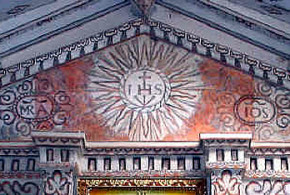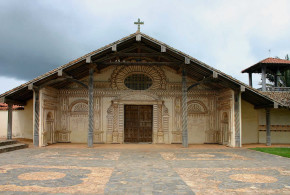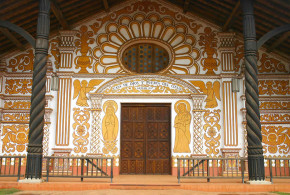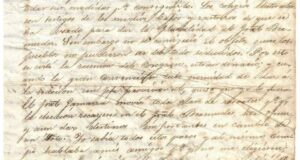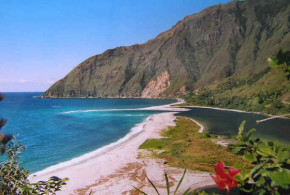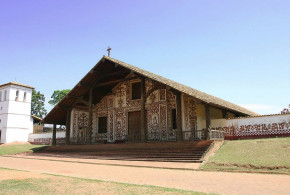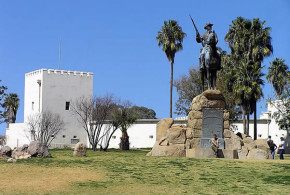This post is also available in:
![]() Deutsch
Deutsch
Written by Dietrich Köster
German-Micronesia – also called “Island Territory” of German New Guinea – is the far-flung island world north of the equator in the Western Central Pacific and was up to 1914/1920 the northern part of German New Guinea, supplemented by the island of Nauru, lying just south of the equator. The land area is only slightly more than 2,500 sq. km. The population amounted to 62,000 in 1914 and now stands at 176,000. Altogether German-Micronesia consisted of the Mariana Islands excluding Guam, the Palau Islands, the Caroline Islands and the Marshall Islands with Nauru. There is a total of 2141 islands, of which only 98 are inhabited.
The Marianas, an island chain north of the island of Guam, had been colonized from 1565 to 1898 by Spain. Thus at the time of the purchase of these islands by the German Empire from Spain after the Spanish-American War the new German colonial authorities found a strong Spanish influence similar to the situation in Latin America. Incidentally, the Marianas were not administered directly from Spain for centuries but until the independence of Mexico were managed by this country. This was followed by an administration from Manila. The Mariana Islands lie on the way from Mexico to the Philippines. Here the Spanish galleons took aboard fresh provisions. With the loss of the Philippines in the above-mentioned war Spain was no longer interested in the Micronesian island possessions, selling them to the German Empire in 1899.
During the transfer of the Mariana Islands, the Imperial District Officer Georg Fritz in Garapan (on the island of Saipan) was appointed by the Governor of the Colony German New Guinea Rudolf Bennigsen. The District Officer provided active development from 1899 to 1907. Thus he founded a government school for indigenous children, holding classes himself until the arrival of the first teacher.
Already at the beginning of World War I Japanese naval forces occupied the islands. As there were no armed forces for German New Guinea, including the Mariana Islands, only a small police force, the Germans did not offer resistance to the Japanese.
The Island Territory of German New Guinea also included the Palau Islands. The flag-raising ceremony was performed from a German warship in 1885 but had to be annulled due to Spanish protests. The Spaniards claimed earlier rights of possession since the 16th century, but without having ever set foot on these islands. By arbitration of the Pope, Spain was to have retained these islands, but with the requirement to send administrative and military personnel to take over the islands effectively.
The same situation prevailed in 1885 on the island groups of Yap, Truk and Ponape, which form the Caroline Islands. Only now Spain was starting colonization here as well. Spanish Catholic priests took up their missionary work on the islands. The Spanish presence did not only come to an end on the Marianas and the Palau Islands in 1899. Following its defeat in the Spanish-American War and the loss of the Philippines, Spain also sold the Caroline Islands to the German Empire. In Yap Arno Senft took office as District Officer and in Ponape Dr. Albert Hahl took office in the same capacity. Palau and Truk each received a Station Officer.
In 1910/11 a revolt broke out over the question of providing a road construction labor force from among the locals of Ponape. After the assassination of the District Officer Gustav Böder four warships of the German East Asia Squadron, stationed in Tsingtao/German Kiautschou Territory, were ordered to Ponape. In a difficult guerrilla war ship crews could wrestle down the insurgents on the Dschokadsch Rock of the Sokehs Peninsula. The ringleaders were executed. Others involved in the uprising were exiled to the Palau Islands.
At the beginning of World War I the Palau and the Caroline Islands also suffered the fate of the Japanese conquest, the Germans not offering resistance.
The German takeover of the Marshall Islands east of the Caroline Islands took place in a different way. As Spain did not claim any property rights, the flag-raising by SMS Nautilus could be maintained in 1885. The main island area with Jabwor on the Jaluit Atoll became the seat of the German governor of the Colony of the Marshall Islands. In 1888 an inter-clan feud was settled by the Germans on the island of Nauru, located further to the south, which was declared part of the Marshall Islands administratively.
Until 1906 the private Jaluit Trading Company administered this archipelago on behalf of the German Empire as a chartered company. As Australia did not accept the trade monopoly of the Jaluit Company any longer, this company was not only deprived of its monopoly but also the sovereign rights over the Marshall Islands were revoked. Germany created an administration of its own now within the framework of German New Guinea by installing a District Officer in Jabwor and a Station Officer on Nauru Island. From 1906 the latter island experienced a dynamic boom. The discovery of rich phosphate deposits, which covered most of the island, was the basis for rapid economic development. With the outbreak of World War I an end was also put to the German activity here. As the Australian Navy arrived here prior to the Japanese one, the island was occupied by the Australians in 1914, whereas the Marshall Islands proper were seized by the Japanese.
The Versailles Peace Treaty, which came into force on 10 January 1920, stipulated that the Mariana Islands, the Palau Islands, the Caroline Islands and the Marshall Islands excluding Nauru, were entrusted to Japan as administering power under a C-mandate from the League of Nations as holder of sovereignty. An equivalent mandate administration for Nauru was established on the basis of this Treaty with Australia as administering power, also on behalf of Great Britain and New Zealand.
In the inter-war period the economy of the entire island area of Micronesia was quickly interpenetrated by the Japanese, with the exception of Nauru. Although the Marianas with their large sugar cane plantations and big sugar mills represented the focus of economic activity, the central headquarters of the Japanese South Seas area – called Nan-yo – became Koror in the Palau archipelago. Here a city was built from the ground, which was hardly different from a provincial city in Japan. The attempt of complete Japanization of Micronesia was typical for the years 1920-40. Thus the immigration of Japanese was heavily promoted officially, which made the local population a minority in their own island area. As from 1936 it was very difficult for a non-Japanese to travel to these islands. The Japanese started to fortify the mandated territory in the framework of their plans of conquering more islands of the Central Pacific. The Truk Islands were the seat of the headquarters of the Southern Command of their Navy.
After the Japanese raid on Pearl Harbor on 07 December 1941, the Japanese Fleet attacked many islands of the Western Central Pacific and occupied them, one of them being Nauru. This island was immediately fortified and the majority of the Nauruans was deported to Truk. In the course of the defeat of the Japanese in the Pacific during 1944-45 the entire Japanese mandated territory was conquered by U.S. troops. The Australians returned to Nauru in September 1945.
As the Japanese soldiers were known for their fanaticism – Kamikaze serving as an example – the Americans could conquer Nan-yo only with an utmost effort. Particularly fierce fighting took place in Truk, where the U.S. Air Force sank the major part of the Japanese Southern Command’s Fleet.
Heavy fighting developed around the islands Angaur, Peleliu and Koror in the Palau Islands. The fiercest battles occurred around Guam – an unincorporated U.S. territory – and on the Mariana Islands Rota, Tinian and Saipan. On Tinian, the former Japanese air base was hastily enlarged and used as a starting point for the dropping of atomic bombs on the Japanese cities Hiroshima and Nagasaki. On Saipan many Japanese soldiers were not ready to surrender. They plunged from a high rock, which is now called Suicide Cliff. The Japanese and Americans left behind extensive war material on this battlefield.
In 1947 the United Nations vested the trusteeship over Micronesia except Nauru in the United States of America as the United Nations Trust Territory of the Pacific Islands (TTPI). The U.S. Government succeeded in acquiring the status of a Strategic Area for this Trust Territory, the sea area of which encompasses 7.8 million sq. km, which equals the total land area of the United States. This was the justification for the USA to carry out various nuclear tests on the atolls of Bikini and Eniwetok of the Marshall Islands until 1958. These provoked numerous protests especially among the resettled Marshallese population. The USA also established a Ballistic Missile Test Site on the Kwajalein Atoll. As a result the Marshall Islanders became welfare recipients of the USA, due to the far-reaching loss of their subsistence agriculture. On Saipan – the main island of the Northern Marianas – many people are beneficiaries of food vouchers, known as Food Stamps, in spite of the recent establishment of textile mills and a thriving tourism industry, thanks to Japanese World War II veterans and honeymooners.
While the small United Nations Trust Territory of the island of Nauru became independent from Australia in 1968 as the Republic of Nauru, by repeal of the UN Trusteeship, and while this island still lives from the export earnings of the phosphate deposits, which are running short, the constitutional and economic future of the U.S.-administered UN Trust Territory of the Pacific Islands was not finalized for a long time.
The USA insist on deploying nuclear weapons on the Palau Islands. In 1979 the Constitution of Palau laid down that this island group is to be a nuclear-free zone. In a number of plebiscites the three-quarters majority required by the Constitution to repeal the provision on the nuclear-free zone had not been achieved. This prevented the ratification of the Association Agreement (Compact of Free Association) with the USA. This compact provides for a high degree of autonomy of the new Republic of Palau, also called Belau. The foreign and defense policy will continue, however, to be cared for by the USA.
On the other hand the Caroline Islands – now called the Federated States of Micronesia (FSM) – and the new Republic of the Marshall Islands (RMI) concluded Compacts of Free Association with the USA. Finally the constitutional status of the Northern Mariana Islands is fixed in such a way that the current status of a “Commonwealth of the Northern Mariana Islands in Political Union with the United States” may later be changed to a proclamation of the Northern Marianas as a 51st State of the USA.
As Palau hesitated to ratify its Compact of Free Association, the UN Trusteeship Council and the UN Security Council finally repealed the UN trusteeship system over the whole area of former German-Micronesia north of the equator – excluding the Palau Islands – on 22 December 1990.
Having overcome constitutional hurdles the Palau Islands ratified the Compact of Free Association with the United States after all. This was finally followed by the lifting of the UN trusteeship system for Palau – now Republic of Palau – on 01 October 1994 as well.
The Compacts of Free Association for the Republic of Palau, the Federated States of Micronesia (FSM) and the Republic of the Marshall Islands (RMI) provide for a strong financial support by the USA and a free access to the U.S. labor market.
In summary it can be said that the island groups of the UN Trust Territory of the Pacific Islands either will not become independent – this is the case of the Northern Mariana Islands – or are held in partial dependence of the United States with regard to foreign and defense policy by Compacts of Free Association. The latter applies to the Republic of Palau, the Federated States of Micronesia and the Republic of the Marshall Islands.
Copyright 2005 by Dietrich Köster, D-53115 Bonn
This post is also available in:
![]() Deutsch
Deutsch
 Colonial Voyage The website dedicated to the Colonial History
Colonial Voyage The website dedicated to the Colonial History

